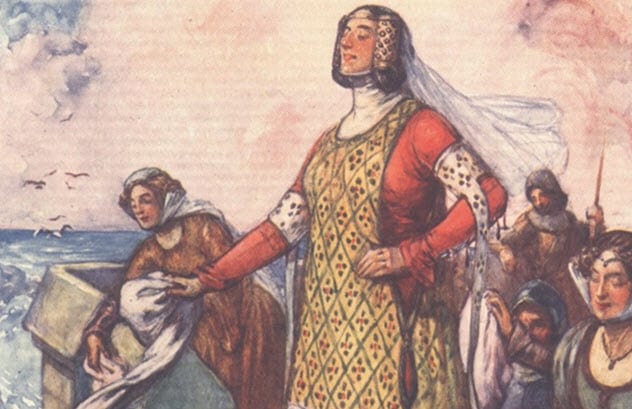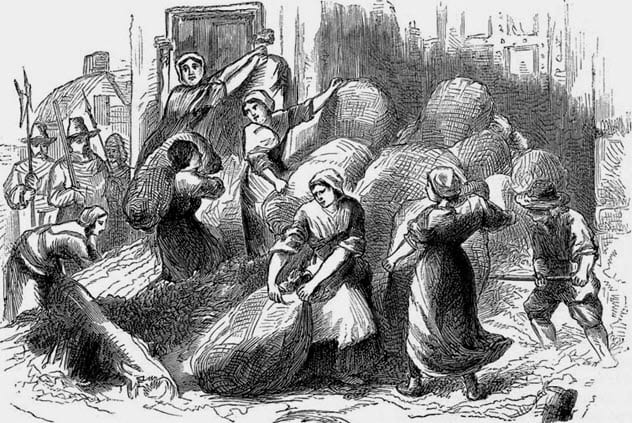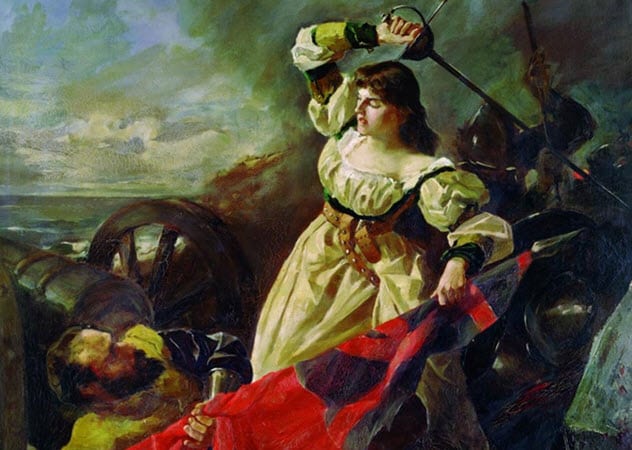 Politics
Politics  Politics
Politics  Weird Stuff
Weird Stuff 10 Eggs-traordinarily Odd Eggs
 History
History 10 Desperate Last Stands That Ended in Victory
 Animals
Animals Ten Times It Rained Animals (Yes, Animals)
 Mysteries
Mysteries 10 Devastating Missing Child Cases That Remain Unsolved
 Creepy
Creepy 10 Scary Tales from the Middle Ages That’ll Keep You up at Night
 Humans
Humans 10 One-of-a-kind People the World Said Goodbye to in July 2024
 Movies and TV
Movies and TV 10 Holiday Movies Released at Odd Times of the Year
 Politics
Politics 10 Countries Where Religion and Politics Are Inseparable
 Weird Stuff
Weird Stuff 10 Freaky Times When Famous Body Parts Were Stolen
 Politics
Politics The 10 Most Bizarre Presidential Elections in Human History
 Weird Stuff
Weird Stuff 10 Eggs-traordinarily Odd Eggs
 History
History 10 Desperate Last Stands That Ended in Victory
Who's Behind Listverse?

Jamie Frater
Head Editor
Jamie founded Listverse due to an insatiable desire to share fascinating, obscure, and bizarre facts. He has been a guest speaker on numerous national radio and television stations and is a five time published author.
More About Us Animals
Animals Ten Times It Rained Animals (Yes, Animals)
 Mysteries
Mysteries 10 Devastating Missing Child Cases That Remain Unsolved
 Creepy
Creepy 10 Scary Tales from the Middle Ages That’ll Keep You up at Night
 Humans
Humans 10 One-of-a-kind People the World Said Goodbye to in July 2024
 Movies and TV
Movies and TV 10 Holiday Movies Released at Odd Times of the Year
 Politics
Politics 10 Countries Where Religion and Politics Are Inseparable
 Weird Stuff
Weird Stuff 10 Freaky Times When Famous Body Parts Were Stolen
10 Amazing Tales Of Women In Sieges
For much of the history of warfare, the siege has been the most common form of conflict. The large set-piece battles that we love to think of were relatively rare.
Wars would be fought to capture territories and towns by surrounding them with your army and either waiting to starve your opponents out or attempting to breach the walls. Conversely, people were loath to leave the protection of their walls behind and so were quite happy to stay inside in safety.
In most times and cultures, war has been seen as a man’s game. But when war comes to your door, everyone has to get involved. Women have made some notable contributions to sieges, and here are 10 of the most dramatic tales.
10 Women Of Weinsberg

The Middle Ages was a time of bloody conflict in Europe but also a period that loved tales of trickery and cleverness. When Conrad III laid siege to the town of Weinsberg, it was just such a tale of quick thinking that emerged.
As the Royal Chronicle of Cologne tells the story, the king laid siege to Weinsberg in 1140 because it belonged to his enemy. He was so enraged by the townspeople’s defiance that he was determined to put the defenders all to death.
But being a man of honor, he declared that he would allow the women of the city to walk away unmolested with as many of their possessions as they could carry. The wives and women of the city all acted at once.
Leaving their belongings behind, they each picked up one of the men of the city and walked out in front of the confounded king. When an ally of Conrad III suggested that the women should be stopped, Conrad III allowed them to leave, saying the word of a king should be trusted.[1]
While this has become a popular folktale, the first written source of this story was set down only 30 years after the supposed event. So, many historians see little reason to doubt that it took place as described.
9 Black Agnes Of Dunbar

One of the roles of a great lady in the medieval world was to manage her lord husband’s lands while he was away at war. This led to many besieged castles being commanded by women.
When the English army came to Scotland to attack their northern enemies, they came to the castle at Dunbar expecting an easy victory. But Black Agnes, Countess of Dunbar and March, was not about to give them one.
The English demanded that Agnes surrender. She had few guards inside the castle to help her, but she sent back this somewhat poetic reply: “Of Scotland’s King I haud my house, He pays me meat and fee, And I will keep my gude auld house, while my house will keep me.”[2]
The Earl of Salisbury, who commanded the attackers, answered her rebuff by launching stones at the castle walls. As the catapults stopped firing, Agnes sent her maids to dust off the battlements with white handkerchiefs. When Salisbury tried to bring down her walls with a ram, Agnes had huge boulders thrown down to smash the English machinery.
Having captured her brother, the Earl of Moray, the English paraded him in front of Agnes’s walls and threatened to kill him unless she surrendered. She simply shrugged and told them to go ahead—when he died, she would inherit his lands.
The siege dragged on for five months before the English finally gave up and went home.
8 Dorothy Hazzard At Bristol

The English civil war pitted two groups of believers against each other. The Royalists clung to the notion that God appointed the king, while the Puritans felt that even kings had to follow God’s laws (as the Puritans interpreted them). Dorothy Hazzard (some spell it “Hazard”) of Bristol was just one of the many women who would become embroiled in this conflict.
Bristol was held by the Puritan Parliamentary forces in August 1643 when a Royalist force commanded by Prince Rupert attacked. Outside the walls, the forces of the town were beaten back but the Royalists could not penetrate the walls.
When the besieging forces seemed about to breach the Frome Gate, Dorothy Hazzard and her friend Joan Batten led a group of women and children with bales of wool and soil to block it up. She even offered to lead a force of women outside to act as human shields and “dead the bullets” of the Royalist forces. The governor of the town turned down this suggestion and soon surrendered.
After the war, the governor was put on trial for his cowardice and the ease with which he gave up the town. One of the witnesses against him was Dorothy Hazzard.[3]
7 Nicholaa De La Haye

Born in 1150, Nicholaa de la Haye was lucky enough to enter the world as a great heiress to lands and castles in England. But she had the bad fortune to be born into a time of great troubles for the country.
King Richard the Lionheart is fondly remembered, but he was largely absent from England during his reign, leaving the governing of the realm to others. When Nicholaa’s husband was ordered to surrender a castle to the Crown, he refused. But it fell to Nicholaa to defend it. For 40 days, she held out until her husband reached a compromise with the Crown.
When her husband died, Nicholaa was, unusually for a woman, made Sheriff of Lincolnshire and given Lincoln Castle in her own right. She attempted to surrender it to King John on the grounds of her age, but he bade her to protect it for him. When the rebels attacked Lincoln during the Barons’ Rebellion against King John, Nicholaa held the castle, allowing the king to triumph in the Battle of Lincoln.[4]
6 Jeanne Hachette

Jeanne Hachette (aka Joan the Hatchet) was a French heroine nicknamed for her use of an axe in the midst of battle. When the forces of Charles the Bold were besieging Beauvais in 1472, it was Jeanne who rallied the men and saved the town.
There were only 300 soldiers manning the walls of the town, and Charles’s troops soon managed to scale the defenses. As one attacker planted his banner on the battlement, it seemed that the battle was already lost.
It was then that Jeanne ran up with her hatchet and cut down the banner or, in some versions, the knight holding it. Her act of heroism inspired the rest of the defenders, and for 11 hours, they fought back until Charles the Bold had to make a less than bold retreat.[5]
For her role in the siege, Jeanne was granted marriage to a man she loved. Also, an annual parade was instituted in the city that paid tribute to the women who defended it.
5 Women Of Carthage

The war between Rome and Carthage was one of the greatest struggles of the ancient world. Two mighty empires were expanding across the Mediterranean, and neither could allow the other to prosper at their expense. The Punic Wars that resulted set the stage for Roman domination of Europe for centuries.
After many hard battles, the city of Carthage came under siege by Roman troops. Those inside Carthage knew that this was a battle for survival. The women of the city gave up their jewelry to pay for the city’s defense. They even cut off their hair to make bow strings and ropes for catapults.
Men and women toiled together to make weapons for the coming fight. Even the temples were turned into factories where women worked through the night.
The Carthaginians put up a strong defense, but the Romans were not about to give up. To completely close off the city, they began to build massive earthworks into the sea to shut Carthage’s harbor.
To counter this, the Carthaginians dug a new channel to the sea—with women and children doing much of the work. When the passage to the sea was complete, the Carthaginian navy sailed out to meet the Romans.[6]
But it was too little, too late. Carthage fell, and the men of the city were put to death while the women and children were carried off to slavery. The Roman general Scipio wept to see it happen. Not because he pitied the Carthaginians but because he realized that one day even Rome might fall.
4 Maria Pita

Maria Mayor Fernandez de Camara y Pita, more pithily called Maria Pita, was the heroine of the siege of Coruna in 1589. English forces under Admiral Sir Francis Drake were raiding Spain in retaliation for the failed invasion of the Spanish Armada the year before.
The English were poorly prepared but still managed to capture the lower part of the city. They were about to seize the fortified heart of it when the battle was turned.
Maria and several other women had gone to join their husbands on the walls. A crossbow bolt felled Maria’s husband, but she continued fighting. An English soldier that managed to reach the wall was killed by Maria, and she stood on the battlements to shout, “Whoever has honor, follow me!”[7]
The others did follow her, and the English were driven back. For her bravery, Maria was granted a pension. A statue of her now stands in Coruna.
3 Sichelgaita Of Salerno

Sichelgaita of Salerno was the 11th-century wife of the notably warlike Robert, Duke of Apulia. While many women were left behind during war, it seems to have been Sichelgaita’s habit to follow her husband into battle or even lead the troops herself.
At the battle of Dyrrhachium, she rode beside Robert in full armor. When she saw some of her own troops retreating, she picked up a spear and charged at them to drive them back into the fight. She shouted, “How far will you run? Stop, be men!”[8]
Other accounts have Sichelgaita being wounded by an arrow during a battle or nearly being captured during a naval skirmish. Not only was she part of Robert’s army but she was sometimes placed in command. For example, she led the siege of Trani in 1080 while Robert moved on to another battle.
2 Arachidamia Of Sparta

Sparta was famous in the Greek world for the liberties given to its women. While respectable women in Athens were supposed to be kept in the house and never seen by men outside their family, women in Sparta were allowed to own property and shape public affairs.
When the Spartan queen Gorgo was asked, “Why is it that you Spartan women are the only women that lord it over your men,” she said, “Because we are the only women that are mothers of men.” Queen Arachidamia was an equally feisty Spartan.
When King Pyrrhus of Epirus set out on one of his conquering sprees, he turned his sights on Sparta. By the third century BC, Sparta was not the fearsome military force it had once been and their king was away elsewhere. It seemed obvious that Sparta would fall.
When the men still in the city considered sending the women and children away to safety, Arachidamia marched into the city council with a sword in her hand. “How do you expect us to survive the destruction of our city?” she asked them. They set about defending the city.
As part of their defenses, the Spartans dug a trench to slow Pyrrhus’s charge. One-third of the trench was completed by the women and children. Sparta was saved.[9]
1 Unknown Mother

Pyrrhus of Epirus was a bit mad when it came to battles. He won and lost several kingdoms over the course of his life. He also gave his name to “pyrrhic victories” when he won a battle at such great cost that he was done for if he had many more such triumphs.
Still, he just could not seem to shake the urge for warfare. Immediately after his defeat at Sparta, he went to attack the city of Argos and it was a woman who stopped him in his tracks again.
He breached the walls of the city, but the narrow streets soon became clogged with men. While trapped there, a defender managed to wound the king with a spear. Pyrrhus immediately attacked the man. This proved to be a mistake—the man’s mother was watching.
The women of Argos were watching the fighting from the rooftops. When this unnamed mother saw her son being attacked, she pulled off a roof tile and flung it at Pyrrhus. Catching him on the back of the neck, it knocked Pyrrhus from his horse and stunned him. He was dragged into a doorway by enemy soldiers and beheaded, probably much to the satisfaction of the watching mothers above.[10]
For more fascinating facts about sieges, check out 10 Of The Deadliest Sieges In History and 10 Of The Longest Sieges In History.








